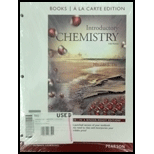
Interpretation:
Explain the Le Chatelier’s principle by using question 12.
Concept Introduction:
When a
When a chemical reaction which is in equilibrium is disturbed, then a principle is used to minimize the disturbance known as Le Chatelelier’s principle.
Le Chatelelier’s principle states that every chemical reaction tries to minimize the disturbance of equilibrium. On increasing the concentration the equilibrium shifts in the direction where the concentration is less.
Interpretation:
Explain the Le Chatelier’s principle by using question 12.
Concept introduction:
Initially the concentration of reactant is maximum and concentration of product is almost zero in a chemical reaction
In starting of the
In final stage concentration of product is more than the reactant.
Want to see the full answer?
Check out a sample textbook solution
Chapter 15 Solutions
Introductory Chemistry, Books a la Carte Edition (5th Edition)
- Because carbonic acid undergoes a second ionization, the student in Exercise 12.39 is concerned that the hydrogen ion concentration she calculated is not correct. She looks up the equilibrium constant for the reaction HCO,-(aq) «=* H+(aq) + COf'(aq) Upon finding that the equilibrium constant for this reaction is 4.8 X 10“H, she decides that her answer in Exercise 12.39 is correct. Explain her reasoning. A student is simulating the carbonic acid—hydrogen carbonate equilibrium in a lake: H,CO,(aq) 5=6 H+(aq) + HCO,'(aq) K = 4.4 X 10'7She starts with 0.1000 A1 carbonic acid. W hat are the concentrations of all species at equilibrium?arrow_forwardConsider the equilibrium process depicted in Fig. 17.6. When does the equilibrium state occur?arrow_forwardDescribe any thermochemical (heat of reaction) evidence for the Arrhenius concept.arrow_forward
- Based on the diagrams, chemical reaction, and reaction conditions depicted in Problem 9-81, for which of the diagrams is the numerical value of the equilibrium constant the smallest?arrow_forwardDescribe a nonchemical system that is in equilibrium, and explain how the principles of equilibrium apply to the system.arrow_forwardFor the following reactions, predict whether the pressure of the reactants or products increases or remains the same when the volume of the reaction vessel is increased. (a) H2O(l)H2O(g) (b) N2(g)+3H2(g)2NH3(g) (c) C2H4(g)+H2O(g)C2H5OH(g)arrow_forward
- Chemistry: Matter and ChangeChemistryISBN:9780078746376Author:Dinah Zike, Laurel Dingrando, Nicholas Hainen, Cheryl WistromPublisher:Glencoe/McGraw-Hill School Pub Co
 Principles of Modern ChemistryChemistryISBN:9781305079113Author:David W. Oxtoby, H. Pat Gillis, Laurie J. ButlerPublisher:Cengage Learning
Principles of Modern ChemistryChemistryISBN:9781305079113Author:David W. Oxtoby, H. Pat Gillis, Laurie J. ButlerPublisher:Cengage Learning Chemistry: Principles and PracticeChemistryISBN:9780534420123Author:Daniel L. Reger, Scott R. Goode, David W. Ball, Edward MercerPublisher:Cengage Learning
Chemistry: Principles and PracticeChemistryISBN:9780534420123Author:Daniel L. Reger, Scott R. Goode, David W. Ball, Edward MercerPublisher:Cengage Learning  Chemistry for Today: General, Organic, and Bioche...ChemistryISBN:9781305960060Author:Spencer L. Seager, Michael R. Slabaugh, Maren S. HansenPublisher:Cengage Learning
Chemistry for Today: General, Organic, and Bioche...ChemistryISBN:9781305960060Author:Spencer L. Seager, Michael R. Slabaugh, Maren S. HansenPublisher:Cengage Learning Chemistry: Principles and ReactionsChemistryISBN:9781305079373Author:William L. Masterton, Cecile N. HurleyPublisher:Cengage Learning
Chemistry: Principles and ReactionsChemistryISBN:9781305079373Author:William L. Masterton, Cecile N. HurleyPublisher:Cengage Learning





